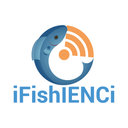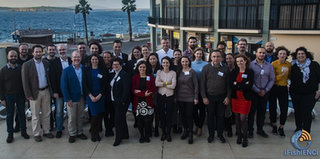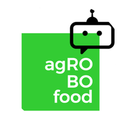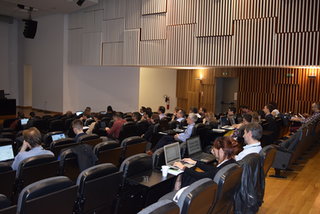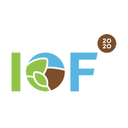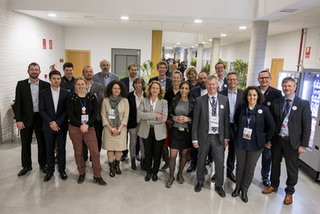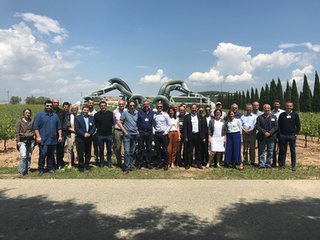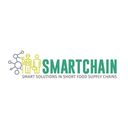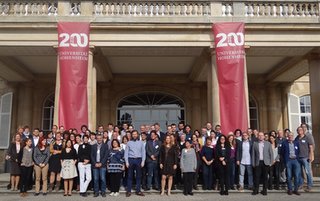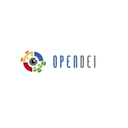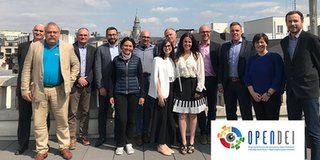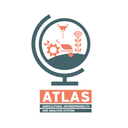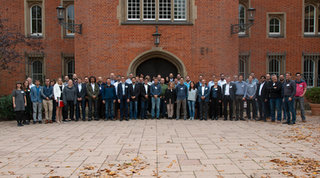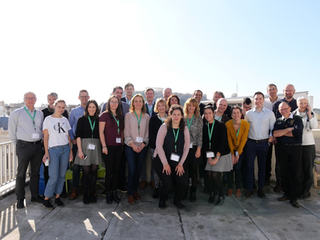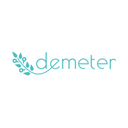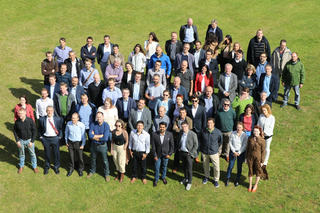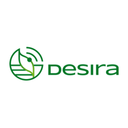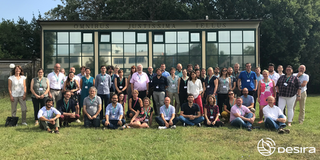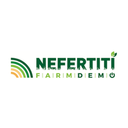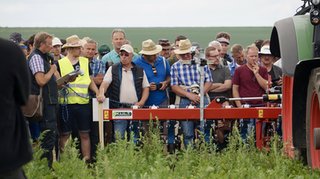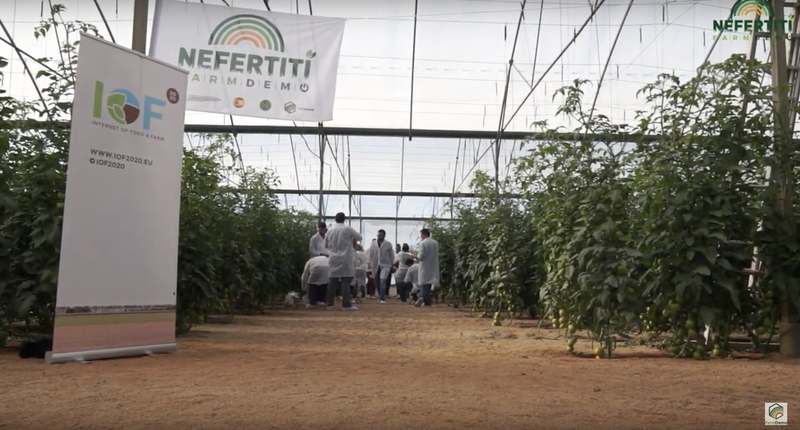synergy
For this anniversary edition, SmartAgriHubs got in touch with 11 other Horizon 2020 projects on the digitalisation of agriculture and explored the possibilities for Synergies amongst all of us
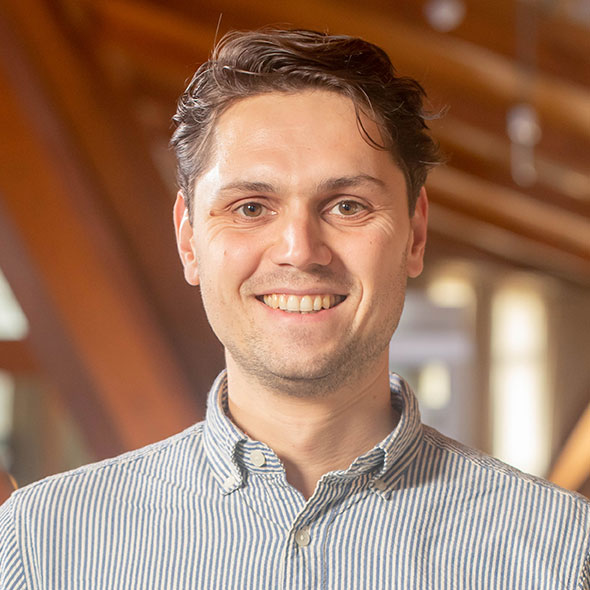
Pieter van Hout
Co-leader of Work Package 1
Eccosystem Building
Quote on the SAH event
“The fastest way forward in sustainability in agriculture is when we collaborate on digitisation and make sure that the people that grow our food will benefit the most. SmartAgriHubs has the potential to be the accelerator to make this happen.”
Special Edition Newsletter
The Kick-off Event was an exhilarating inauguration of our journey. What was your main take-away learning from the event? What stood out?
It was exciting to see so many people working on digitisation in agrifood and focus on the wellbeing of our farmers and our planet.
During the event, visitors were treated to a ‘SmartAgriHubs Tour’ where they were introduced to each Work Package. In the same spirit, can you briefly explain the role of your Work Package and give us an example?
With Work Package 1 we look into the sustainability of the project, both during the project and also after the project finishes. We support the other Work Packages in getting the most out of SmartAgriHubs.
ATLAS – Agricultural Interoperability and Analysis System
What is the goal of the project ATLAS?
The goal of ATLAS is to achieve a new level of interoperability of agricultural machines, sensors and data services. Besides, ATLAS enables farmers to have full control over their data and decide which data is shared with whom in which place. We also implement and demonstrate this technology within multiple pilot studies covering real-world use cases.
What accomplishment(s) did you celebrate last year?
We won the project and started working on it. We have had a successful kick-off meeting in October and we now have a mature definition of the use cases.
What do you hope to accomplish this year and why?
We hope to finish setting up demonstrators for all the pilot studies and conducting experiments this year. We want to collect, but also process the data from all the pilot studies. Besides, we strive to start the first round of the open calls in 2020.
What synergy do you see between your project and SmartAgriHubs?
We see a lot of synergy between ATLAS and SmartAgriHubs. We collaborate and exchange between the Competence Centers: ATLAS also establishes centres of competence with technology demonstrators. It would be great to have join events in these centres in the future. We do not only exchange data between ATLAS and SmartAgriHubs, but we also exchange knowledge and technology.
Contact information
Stefan Rilling
stefan.rilling@iais.fraunhofer.de
https://www.atlas-h2020.eu/
DEMETER - EMPOWERING FARMERS
What is the goal of your project?
The DEMETER project is a large-scale deployment of farmer-centric, interoperable smart farming-IoT (Internet of Things) based platforms, delivered through a series of 20 pilots across 18 countries (15 EU countries). Involving 60 partners, DEMETER adopts a multi-actor approach across the value chain (demand and supply), with 25 deployment sites, 6,000 farmers and over 38,000 devices and sensors being deployed.
What accomplishment(s) did you celebrate last year?
Our project started in September 2019 and has had a number of deliverables to date. In particular from our piloting work package. We have created a comprehensive list of requirements for our pilots that cover all aspects and stakeholders – it is an excellent reflection of the Multi-Actor Approach we have adopted. Additionally, we have had a number of presentations and publications even at this early stage of development.
IWhat do you hope to accomplish this year and why?
In 2020 the project efforts ramp up significantly. Of high significance is the fact that we will start our technical developments and piloting activities, as well as launching our first phase of cascade funding. This funding aims to attract new participants to our already substantial stakeholder base. On top of this we are co-organising events such as the Agri/ICT sessions at the upcoming IoTWeek in Dublin in June.
What synergy do you see between your project and SmartAgriHubs?
There are a lot of synergies, not least of which is the fact that we have many partners in common. Additionally, through our pilots we will be in a position to identify a number of Digital Innovation Hubs that may be of interest to SAH – while at the same time we would hope to use the communication mechanisms within SAH to promote our project outputs and calls for cascade funded partners.
Contact information
Kevin Doolin
kdoolin@tssg.org
http://h2020-demeter.eu/
https://www.linkedin.com/company/h2020-demeter/
DESIRA – Digitisation: Economic and Social Impacts on Rural Areas
What is the goal of your project?
DESIRA is a project that aims to improve the capacity of society and political bodies to respond to the challenges and opportunities that digitalisation generates in rural areas, agriculture and forestry.
Digitalisation is a process of social transformation driven by information technologies and it can be a key driver of sustainable development. Yet, digital technologies can have deep repercussions on people’s lives, meaning that it can generate winners (who benefit from it), but also losers (who are marginalised) and opponents (who resist and elaborate alternative rules of the game). Thus, it is important to understand the advantages and disadvantages of rural digitalisation, and how this process can lead to more sustainability and wellbeing for the rural communities.
With this in mind, the project is developing a methodology and knowledge base that makes it easier to assess the past, current and future socio-economic impacts of ICT-related innovation in rural areas, agriculture and forestry.
What accomplishment(s) did you celebrate last year?
DESIRA had its starting point last year, with a kick-off meeting held in September 2019. One of the accomplishments that we celebrate is the set-up of 20 Living Labs across Europe that will help the project connect with local networks of rural businesses, public authorities, citizen groups, digital technology operators, farmers and researchers. These networks will co-develop ideas, scenarios, and socio-technical solutions related to digitalisation in rural areas.
What do you hope to accomplish this year and why?
This year we are organising the first EU Rural Digitisation Forum in September 2020 that will gather experts from agriculture, forestry and rural areas, to discuss the potential impacts of digitalisation on these three sectors. The group of experts is expected to contribute to specific DESIRA research outputs such as identifying the digital game changers in rural areas, building DESIRA’s conceptual framework, developing the socio-economic impact assessment framework, carry out an EU-level digital scenario exercise, and contribute to the development of policy recommendations.
Additionally, we will be able to define and identify examples of Digital Game Changers. By the end of the project, DESIRA will have identified 300 examples of Digital Game Changers.
Interested stakeholders are welcome to join the EU Rural Digitisation Forum by signing up here.
What synergy do you see between your project and SmartAgriHubs?
Synergies among the two projects can be established especially regarding the agriculture sector, as both projects are looking at the potential of digital technologies and digital transformation and their impact on the sector. This is a very strong link where both projects can collaborate and engage with each other, sharing knowledge, expertise and best practice examples. We see opportunities within the EU Rural Digitisation Forum, where SmartAgriHubs can engage directly with experts from across the focus sectors; and also within the expert working groups that will be set up for agriculture, forestry, rural areas and policies. These working groups will gather experts from the sectors to provide outstanding contributions to the research activities of the project.
Interested stakeholders can stay up to date with the project by following it online or through the newsletter.
Contact details
Roxana Vilcu
roxana.vilcu@aeidl.eu
http://desira2020.eu/
agROBOfood – building a European ecosystem for the effective adoption of robotic technologies
What is the goal of your project?
agROBOfood is an EU funded project aiming to build a European ecosystem for the effective adoption of robotic technologies in the agri-food sector making it thus more efficient and competitive.
The heart of the project is formed by Innovation Experiments, organized and monitored by Digital Innovation Hubs. Seven initial Innovation Experiments are already being implemented within the framework of the project and their goal is to showcase that robotic technologies can be replicated and widely adopted by the agri-food sector, across Europe. The role of the Digital Innovation Hubs is to support the companies involved in those experiments and to enhance their work by connecting them to various stakeholders and giving them access to services, knowledge and know-how that they need.
agROBOfood already counts 49 Digital Innovation Hubs within its network, which will be extended and strengthened during the lifetime of the project through various activities, including the "Open Calls"!
What accomplishment(s) did you celebrate last year?
Two were the major milestones that were achieved for agROBOfood up until now! The first one was the official kick off of the project, during which we succeeded to bring the whole consortium together. More than 50 participants attended the official universal launch for our project. That was an important milestone, since all consortium members were present, they were informed on the various aspects, and agROBOfood from the conception phase entered to the implementation phase!
The second one was the recent launch of the 1st Open Call for innovation experiments, which aims to:
support industry, in particular SMEs of the agri-food sector, in their digital transformation, through demonstrators and platforms development, technology transfer experiments and other services;
allow the European automation industry (agricultural machinery, material handling, etc) to benefit from the opportunities of guiding, supporting and teaming up with start-ups and SMEs from the robotics sector;
mobilize private matching funds (e.g. acquisitions by big industrial players, corporate VC investments), that will support the scale-up of robotic technologies and accelerate the digital transformation of the agri-food sector.
What do you hope to accomplish this year and why?
To manage and expand our network and build towards enhancing the adoption of the robotics in the agricultural sector! It is very important to communicate, not only to stakeholders but to the wider public as well, that robotics can help in producing more with less!
During the first few months of the project we have laid down the groundwork to achieve that. We have developed, and we are continuously enhancing multiple means and tools that will help us bring the different actors of our ecosystem on-board and form a vibrant and energetic community of robotics for the agricultural sector!
What synergy do you see between your project and SmartAgriHubs?
Both projects aim at enhancing the agricultural sector through the deployment of new technologies. Although agROBOfood will do it through the deployment of robotic technologies specifically, the main goal for both projects remains the same: to realise the digitalisation of the European agriculture! In that framework various synergies between the two projects can be foreseen, like building common ecosystems that will include DIHs, CCs and SMEs that will be able to provide a wide range of services and know-how.
Contact information
Staša Stojkov Rošić
stasa.stojkov@biosense.rs
https://agrobofood.eu/project/
INNOSETA
What is the goal of your project?
INNOSETA aims to fill the gap between research and stakeholders such as farmers, advisors and policy makers. We do so by creating an online platform. On this platform, we bring together and classify, organize and clearly manage readily available materials, that are now still scattered over a large number of websites. The INNOSETA platform is aimed at all aspects related to crop protection, ranging from new developments to best management practices, including training and advising materials.
What accomplishment(s) did you celebrate last year?
Innoseta was officially launched on May 2018. Last year, in 2019 we were happy to announce the official launch of our online platform. The platform can now be accessed through https://platform.innoseta.eu/.
What do you hope to accomplish this year and why?
For the time being, we focus on improving the platform, on disseminating our results among the stakeholders involved, and on creating synergies between the different actors involved in crop protection.
What synergy do you see between your project and SmartAgriHubs?
INNOSETA represents one additional tool, which is aimed at raising the knowledge level of agricultural stakeholders in Europe. In that sense, it is directly linked to the main objectives of SmartAgriHubs.
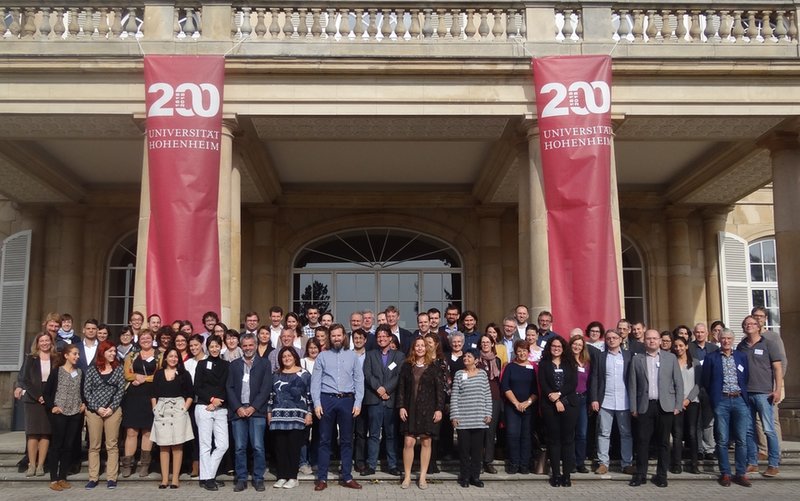
smartchain
What is the goal of your project?
The central objective of the SMARTCHAIN project is to foster and accelerate the shift towards collaborative Short Food Supply Chains (SFSCs) and, through specific actions and recommendations, to introduce new robust business models and innovative practical solutions that enhance the competitiveness and sustainability of the European agri-food system.
What accomplishment(s) did you celebrate last year?
Last year SMARTCHAIN has developed an operational framework for the comparative analysis of 18 selected case studies (SFSCs) within a multi-actor environment. This multi-perspective analysis of SMARTCHAIN SFSCs was carried out using developed questionnaires in terms of technological & non-technological innovations, social innovations, consumer perceptions, life cycle sustainability and their national/regional regulatory contexts in 7 EU and 2 associated partner countries. Based on the results of the multi-perspective analysis, different tasks have been carried out:
Technological & non-technological innovations for SFSCs have been identified, analysed and collected in an inventory.
An operational and inclusive definition of social innovation in SFSCs has been provided and validated with the organisation of 12 Community of Practice in 9 countries.
An exploratory research on consumer attitudes and perceptions (qualitative study) has been carried out through the implementation of 8 consumer focus groups in Germany, Spain, Greece and Hungary and 32 expert stakeholder interviews in Belgium, Germany, the Netherlands, Switzerland, Spain, Greece and Hungary.
The system under study and the methodology for environmental and socio-economic assessment of selected case studies have been defined.
A selection of successful ongoing innovations has been individually analysed (determining key factors concerning their successful application) to create tools to support the practical implementation of innovative solutions in SFSCs.
The SMARTCHAIN Innovation Platform has been developed, where the results obtained from different Work packages feed the different inventories and interactive tools.
What do you hope to accomplish this year and why?
This year SMARTCHAIN will carry out the following actions:
The identification of the typical bottlenecks for SFSCs and potential success factors for enhancing their performances considering their food chain channel type, the stages of the chain and the regional, national differences;
Based on methodologies developed during last year, the collection and analysis of qualitative and quantitative data on social innovations from the 18 case studies;
A quantitative research in order to validate and quantify consumer expectations, attitudes and preferences with regard to food provided by SFSCs using an online survey in 4 countries (Germany, Spain, Greece and Hungary) with a target sample size of 500 consumers in each country;
The environmental and socio-economic modelling and impact assessment based on the data collected from 7 selected case studies, using a developed qualitative and quantitative questionnaire;
The development of training materials and an e-learning course on “best practices in innovation” for farmers and SFSCs practitioners. All these materials will be available in the SMARTCHAIN innovation platform. Also an International Community of SFSCs will be built and implemented in the platform;
The creation of a best practice guide for helping SFSCs in the practical implementation of identified technological, non-technological and social innovative solutions;
The development of an inventory of reference exploitation models for SFSCs based on the critical analysis of existing business models of the 18 case studies, and the identified innovative solutions;
Several communication and dissemination actions (e.g. short videos explaining the project results, infographics, E-newsletters, articles, etc.), including the first round of national multi-stakeholder workshops in 9 countries.
What synergy do you see between your project and SmartAgriHubs?
Both projects have developed an online portal/platform, SmartAgriHubs Innovation Portal and SMARTCHAIN Innovation Platform, where innovative practical solutions, relevant initiatives and best practices can be found for different stakeholders (e.g. farmers and SFSCs practitioners, technology providers). Additionally, training materials such as webinars and e-learning courses will be made available through SMARTCHAIN. These two online platforms could be very useful tools for synergy between both projects, facilitating the exchange of relevant information (e.g. digitalisation & automation solutions, initiatives, networking options). Both projects could also promote the use of the other online platform between their partners and target groups through their social media and own events. Similarly, each project could communicate & disseminate general information regarding the other project (e.g. overview of the project, events, relevant results) through their own channels.
Furthermore, SMARTCHAIN Hub Managers will organise national Multi-stakeholder workshops in 9 countries for farmers, SFSCs practitioners and other stakeholders. Here, representatives from the corresponding SmartAgriHubs Digital Innovation Hubs could participate to share important information (objectives/actions/activities) and to disseminate the most relevant results of the project. In the same way, SMARTCHAIN Hub Managers could participate in national SmartAgriHubs events to present our project and results.
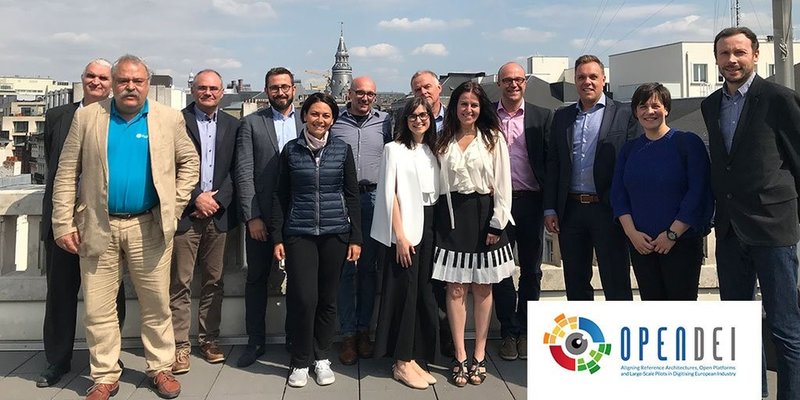
open dei-“Aligning Reference Architectures, Open Platforms and Large-Scale Pilots in Digitising Digitalizing European Industry”
What is the goal of your project?
The main goal of our project is “opening the eyes” of the European industry and society to the benefits of Digital Transformation.
Working in the context of sectors highly impacted by Digital Transformation, including Agri-food, OPEN DEI project represents an essential pillar of the implementation of EU digitisation policies. This is done by addressing in particular the “support” for the Large-Scale Pilots and platform projects financed by the European Commission under the Digitising European Industries Focus Area and currently running. OPEN DEI aims at leveraging synergies, identifying gaps, sharing best practices, reinforcing both regional and national relationships. Also, putting in place the necessary joint measures to implement common dissemination, communication, training and exploitation action plans among the Innovation Actions implementing the EU DT strategy. The OPEN DEI Ecosystem is currently composed of 26+ projects in four domains.
Innovation streams where OPEN DEI may support LSP and network of Digital Innovation Hubs:
Platform Building: compare reference architectures of the participating initiatives and support building Digital Platforms in different vertical domains, improve interoperability between platforms and enable a unified industrial data platform.
Data ecosystems: Enabling an innovation and collaboration ecosystem, contributing to industrial skills catalogue and observatory.
Large Scale Piloting: create synergies between pilots across different domains, creating a set of assessment methods and a migration journey benchmarking tool.
Standardization: overview of standardization actors and efforts, identify gaps and possible solutions, building alliances with existing European Union and standard developing organisations. Define cross-sectorial data models for B2B Data Exchange.
What objective(s) did you achieve last year?
We started on the 1st of June in 2019. The first months of the project were useful to create visibility tools for the project, like a website, leaflets and posters. We also made contacts with Large Scale Pilots involved in EU DT strategy.
Last year we also successfully came up with a definition of the Open DEI share, connect and attract strategy, stakeholders mapping and project visibility.
Besides, we reached ecosystem governance implementation. One ambassador per sector has been identified. For AGRIFOOD, Tecnoalimenti S.C.p.A. (Italy) has been nominated according to its statutory mission and experience in the sector along the supply chain. Its role will be to maintain active contacts with LSPs and other agricultural projects involved in ICT and robotics/cobotics. Lastly, we set up sectorial working groups and needs or topics for cooperation identification for every sector.
What do you hope to accomplish this year and why?
We hope to accomplish the following this year:
We want to set up coordination activities and support services for alignment of reference architectures, interoperability patterns and common cross-domain Industrial Data Sets and components identification. Designing a Digital marketplace of Open Source components and Industrial Data Platform for B2B Data Exchange.
Next to that, we want to launch the Large Scale Piloting dashboard and the first version of best practices for large scale piloting and benchmarking tool.
We also want to create the OPEN DEI ecosystem enabling cross-domain collaboration, partnership, events, knowledge sharing and new DIH coaching. Launching OPEN DEI Industrial skills catalogue.
Lastly, we aim for a publication of a study of standardization state of art, identify gaps and recommendations.
What synergy do you see between your project and SmartAgriHubs?
OPEN DEI wishes to set up a win-win collaboration with the platform projects financed by the European Commission under the Digitising European Industries Focus Area and currently running, which work in different strategic sectors: one of them is represented by agri-food. In such domain, we have identified as our win-win partners the two LSPs projects, Demeter and Atlas, as well as some existing projects such as IoF2020, SmartAgriHubs and AgROBOfood.
Contacts:
Marianna Faraldi
Silvia Castellvi Kembügler
silvia.castellvi@internationaldataspaces.org
NEFERTITI-Networking European Farms to Enhance Cross Fertilisation and Innovation Uptake Through demonstration
What is the goal of your project?
The overall objective of NEFERTITI is to establish an EU-wide highly connected network of demonstration and pilot farms designed to enhance knowledge exchanges, cross fertilization among actors and efficient innovation uptake in the farming sector through peer-to-peer demonstration of techniques on 10 major agricultural challenges in Europe.
What accomplishment(s) did you celebrate last year?
We run a demonstration campaign and organised 267 agricultural demonstration events in 2019, with 12,000 participants across Europe, including 6,000 farmers and 3,400 advisors and students.
What do you hope to accomplish this year and why?
We hope to maintain and increase the number of demonstration events. However, we want to increase their impact through higher quality of the demonstration techniques (Using Farm Demo Demonstration best practices). We also want to increase the cross-border exchanges between farmers and advisors across Europe, to raise cross fertilisation and innovation uptake.
What synergy do you see between your project and SmartAgriHubs?
We see multiple synergies between NEFERTITI and SmartAgriHubs. The connection of farmers with digital companies, industries and research centres for example. This connection will allow a better understating of farmers’ needs to elaborate relevant solutions. Next to this, we plan to organise joint events to demonstrate the readiness of digital solutions to the farming sector.
We also want to team up with Internet of Food and Farm and SmartAgriHubs, as we believe that we could increase the impact of both projects through on-farm demonstration of their findings.
Contact information
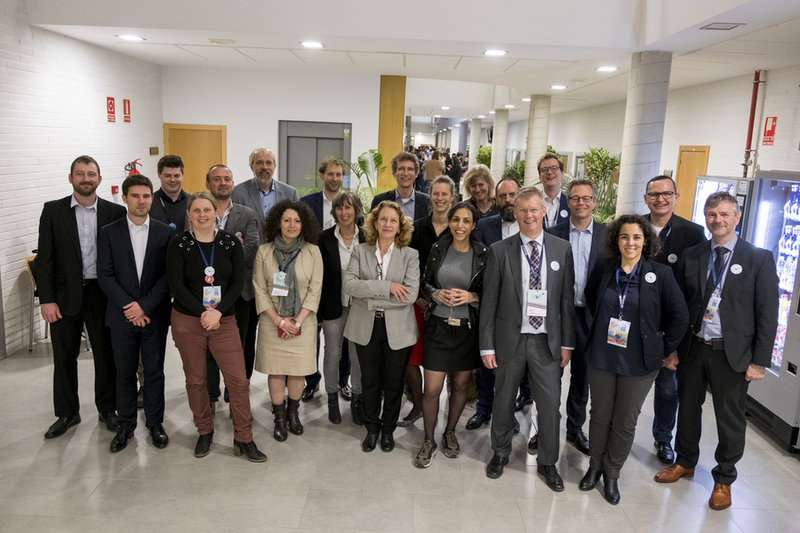
Internet of Food and Farm 2020
What is the goal of your project?
IoF2020 aims at doing better what we already do. It paves the way towards data-drive farming that is capable of providing higher production yields in a more sustainable and environmentally-responsible fashion, while also making the European farming sector more competitive in an increasingly globalized world.
What accomplishment(s) did you celebrate last year?
The successful integration of 14 new use cases in the IoF2020 ecosystem. We now cover even more solutions, and are active in 22 EU member states! Furthermore, we have put a lot of effort in establishing connections with other, similar H2020 initiatives. SmartAgriHubs and Nefertiti are for example projects that we have good connections with, but we are also connected to other EU-level players. IoF2020 is now well know and has connections on several levels, also within the farming community.
What do you hope to accomplish this year and why?
This year is the final year for IoF2020. It means that the project needs to deliver what was expected: successful, scalable and functioning IoT solutions for 5 agriculture sectors: Arable, Dairy, Fruit, Vegetables and Meat. We also need to ensure the long term visibility of these project results. This is done through the integration of our use cases in the SmartAgriHubs Innovation Portal, the realisation of our use case catalogue including the video documentaries, and our closing event which will gather and showcase what the project has accomplished.
What synergy do you see between your project and SmartAgriHubs?
You may have the best service or product in the world, if nobody knows about it, it is useless. IoF2020 develops services and solutions, it has its own growing ecosystem, but it can always benefit from additional visibility and connections with an extended range of stakeholders. The SmartAgriHubs ecosystem is perfect for this. On the same hand, the SmartAgriHubs project developed an innovation portal to facilitate the interactions between all the agri-stakeholders which is really business minded. Their motto being “connecting the dots”, it seems only logical that IoF2020 brings even more dots to connect!
Contact details
François Lienard
francois.lienard@schuttelaar-partners.com

Internet of Food and Farm 2020
What is the goal of your project?
IoF2020 paves the way towards data-driven farming that is capable of providing higher production yields in a more sustainable and environmentally-responsible fashion, while also making the European farming sector more competitive in an increasingly globalized world.
What accomplishment(s) did you celebrate last year?
The successful integration of 14 new use cases in the IoF2020 ecosystem. We now cover even more solutions, and are active in 22 EU member states! Furthermore, we have put a lot of effort in establishing connections with other, similar H2020 initiatives. SmartAgriHubs and Nefertiti are for example projects that we have good connections with, but we are also connected to other EU-level players. IoF2020 is now well known and has connections on several levels, also within the farming community.
What do you hope to accomplish this year and why?
This year is the final year for IoF2020. It means that the project needs to deliver what was expected: successful, scalable and functioning IoT solutions for 5 agriculture sectors: Arable, Dairy, Fruit, Vegetables and Meat. We also need to ensure the long term visibility of these project results. This is done through the integration of our use cases in the SmartAgriHubs Innovation Portal, the realisation of our use case catalogue including the video documentaries, and our closing event which will gather and showcase what the project has accomplished.
What synergy do you see between your project and SmartAgriHubs?
You may have the best service or product in the world, if nobody knows about it, it is useless. IoF2020 develops services and solutions, it has its own growing ecosystem, but it can always benefit from additional visibility and connections with an extended range of stakeholders. The SmartAgriHubs ecosystem is perfect for this. On the same hand, the SmartAgriHubs project developed an innovation portal to facilitate the interactions between all the agri-stakeholders which is really business-minded. Their motto being “connecting the dots”, it seems only logical that IoF2020 brings even more dots to connect!
Contact details
François Lienard
francois.lienard@schuttelaar-partners.com
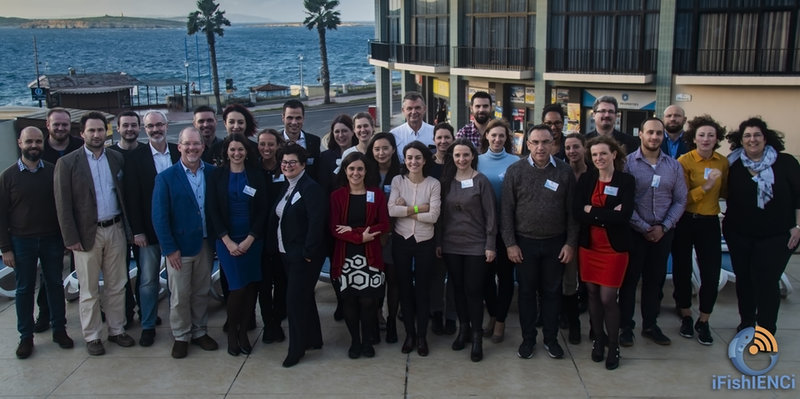
iFishIENCi -Intelligent Fish feeding through Integration of Enabling technologies and Circular principles
What is the goal of your project?
The iFishIENCi EU funded H2020 project is bringing together 16 partners in a trans-disciplinary effort towards making genuine improvements to fish farming worldwide. Fish aquaculture is essential for providing healthy food to a growing world population, but its success depends upon our ability to find more sustainable farming practices. This means more effective ways of monitoring fish-health and welfare, as well as more efficient ways of feeding fish that reduce pressure upon the source of fish-feed ingredients, such as agricultural crops and wild-caught fish for fishmeal and oil. The ambition of iFishIENCi is developing and demonstrating disruptive IoT/AI based innovations, considering the feeding value chain as a whole, and addressing four commercially-important species, with fish quality as focus.
iFishIENCi and SmartAgriHubs share the same values and objectives. How Does iFishIENCi connect with the SmartAgriHubs project?
Aquaculture is connected to the agriculture on many ways and being a food production industry fish farming is facing similar challenges like the agri-food sectors. Digitalization is a key development area which can help both industries to improve and overcome challenges like sustainability, climate change or social acceptance.
What opportunities do you see for (more) synergy between the projects?
SmartAgriHubs can support the aqua- and agri-food sectors to find common solutions and apply best practices from the other sectors. This could be facilitated by organizing joint workshops for aquaculture and agriculture farmers on special issues of the farm digitalization. Bilateral cooperation between iFishIENCi partners and Digital Innovation Hubs (DIH) and exchange information about the innovation experiments also could support the successful implementation of both projects.

